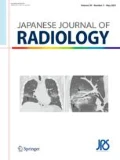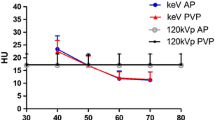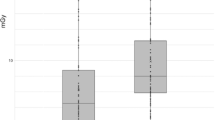Abstract
Purpose
To investigate the effect of automatic spectral imaging protocol selection (ASIS) and adaptive statistical iterative reconstruction (ASIR) technology in reducing radiation and contrast dosage.
Methods
Sixty-four patients were randomly divided into two groups for abdominal computed tomography (CT): the experiment group with ASIS plus 50% ASIR and the control with 120 kVp voltage.
Results
The CT dose-index volume decreased by 23.68 and 23.57% and the dose-length product dropped by 25.59 and 18.45% in the arterial and portal venous phases, respectively, in the experiment than control group. The contrast dose was reduced by 16.86% in the experiment group. In the 55 keV + 50% ASIR group, the arterial contrast-to-noise ratio and scores were significantly (P < 0.05) higher than in the control group in the arterial phase while the portal contrast-to-noise ratio and scores were not significantly different between the two groups (P > 0.05).
Conclusion
The ASIS technique plus 50% ASIR can enhance image quality of the abdominal structures while decreasing the radiation and contrast dosage compared with the conventional scan mode.


Similar content being viewed by others
Abbreviations
- ASIS:
-
Automatic spectral imaging protocol selection
- ASIR:
-
Adaptive statistical iterative reconstruction
- CT:
-
Computed tomography
- BMI:
-
Body mass index
- SNR:
-
Signal-to-noise ratio
- ROI:
-
Region of interest
- ROIo:
-
CT value in the liver parenchyma or vessels
- ROId:
-
CT value in the sacrospinal muscle
- SDn:
-
Mean background image noise
- SD:
-
Standard deviation
- CTDIv:
-
CT dose index volume
- DLP:
-
Dose-length product
- ALARA:
-
As low as reasonably achievable
References
Pearce MS, Salotti JA, Little MP, et al. Radiation exposure from CT scans in childhood and subsequent risk of leukaemia and brain tumours: a retrospective cohort study. Lancet. 2012;380(9840):499–505.
Brenner DJ, Hall EJ. Computed tomography—an increasing source of radiation exposure. N Engl J Med. 2007;357(22):2277–84.
Kennedy TC, Miller Y, Prindiville S. Screening for lung cancer revised and the role of sputum cytology and fluorescence bronchoscopy in high risk group. Chest. 2000;117(4suppl1):72–9.
Limbruno U, Picchi A, Micheli A, et al. Refining the assessment of contrast-induced acute kidney injury: the load-to-damage relationship. J Cardiovasc Med (Hagerstown). 2014;15(7):587–94.
Moore A, Dickerson E, Dillman JR, et al. Incidence of nonconfounded post-computed tomography acute kidney injury in hospitalized patients with stable renal function receiving intravenous iodinated contrast material. Curr Probl Diagn Radiol. 2014;43(5):237–41.
Newhouse JH, Roy Choudhury A. Quantitating contrast medium-induced nephropathy: controlling the controls. Radiology. 2013;267(1):4–8.
Korn A, Fenchel M, Bender B, et al. Iterative Reconstruction in head CT: image quality of routine and low-dose protocols in comparison with standard filtered back-projection. Am J Neuroradiol. 2012;33(2):218–24.
Pontana F, Pagniez J, Flohr T, et al. Chest computed tomography using iterative reconstruction vs filtered back projection (part 1): evaluation of image noise reduction in 32 patients. Eur Radiol. 2011;21(3):627–35.
Singh S, Kalra MK, Gilman MD, et al. Adapteve statistical iterative reconstruction technique for radiation dose reduction in chest CT: a pilot study. Radiology. 2011;259(2):565–73.
Zhao L, Winklhofer S, Yang Z, et al. Optimal adaptive statistical iterative reconstruction percentage in dual-energy monochromatic CT portal venography. Acad Radiol. 2016;23(3):337–43.
Chen CM, Chu SY, Hsu MY, et al. Low-tube-voltage (80 kVp) CT aortography using 320-row volume CT with adaptive iterative reconstruction: lower contrast medium and radiation dose. Eur Radiol. 2014;24(2):460–8.
Zhang C, Yu Y, Zhang Z, et al. Imaging quality evaluation of low tube voltage coronary CT angiography using low concentration contrast medium. PLoS One. 2015;10(3):e0120539.
Delesalle MA, Pontana F, Duhamel A. etal Spectral optimization of chest CT angiography with reduced iodine load: experience in 80 patients evaluated with dual-source dual-energy CT. Radiology. 2013;267(1):256–66.
He J, Wang Q, Ma X, et al. Dual-energy CT angiography of abdomen with routine concentration contrast agent in comparison with conventional single-energy CT with high concentration contrast agent. Eur J Radiol. 2015;84(2):221–7.
Zhu Z, Zhao XM, Zhao YF, et al. Feasibility study of using gemstone spectral imaging (GSI) and adaptive statistical iterative reconstruction (ASIR) for reducing radiation and iodine contrast dose in abdominal CT patients with high BMI values. PLoS One. 2015;10(6):e0129201.
Lv P, Lin XZ, Chen K, et al. Spectral CT in patients with small HCC: investigation of image quality and diagnostic accuracy. Eur Radiol. 2012;22(10):2117–24.
Lv P, Lin XZ, Li J, et al. Differentiation of small hepatic hemangioma from small hepatocellular carcinoma: recently introduced spectral CT method. Radiology. 2011;259(3):720–9.
Yu Y, Guo L, Hu C, et al. Spectral CT imaging in the differential diagnosis of necrotic hepatocellular carcinoma and hepatic abscess. Clin Radiol. 2014;69(12):e517–24.
Yu Y, Lin X, Chen K, et al. Hepatocellular carcinoma and focal nodular hyperplasia of the liver: differentiation with CT spectral imaging. Eur Radiol. 2013;23(6):1660–8.
Lin XZ, Wu ZY, Tao R, et al. Dual energy spectral CT imaging of insulinoma-value in preoperative diagnosis compared with conventional multi-detector CT. Eur J Radiol. 2012;81(10):2487–94.
Lv P, Liu J, Chai Y, et al. Automatic spectral imaging protlcol selection and iterative reconstruction in abdominal CT with reduced contrast agent dose: initial experience. Eur Radiol. 2016;27(1):374–83.
Lee CI, Haims AH, Monico EP, et al. Diagnostic CT scans: assessment of patient, physician, and radiologist awareness of radiation dose and possible risks. Radiology. 2004;231(2):393–8.
Chen A, Liu A, Tian S, et al. Optimal monochromatic images of abdominal arteries with low concentrations of contrast agents in spectral computed tomography imaging. Zhonghua Yi Xue Za Zhi. 2014;94(43):3382–6.
He J, Ma X, Wang Q, et al. Spectral CT demonstration of the superior mesenteric artery: comparison of monochromatic and polychromatic imaging. Acad Radiol. 2014;21(3):364–8.
Zhao LQ, He W, Li JY, et al. Improving image quality in portal venography with spectral CT imaging. Eur J Radiol. 2012;81(8):1677–81.
He J, Wang Q, Ma X, et al. Dual-energy CT angiography of abdpmen with routine concentration contrast agent in comparison with conventional single-energy CT with high concentration contrast agent. Eur J Radiol. 2015;84(2):221–7.
Chen A, Liu A, Tian S, et al. Optimal monochromatic images of abdominal arteries with low concentrations of contrast agents in spectral computed tomography imaging. Zhonghua Yi Xue Za Zhi. 2014;94(43):3382–6.
Yeh BM, Shepherd JA, Wang ZJ, et al. Dual-energy and low-CT in the abdomen. AJR Am J Roentgenol. 2009;193(1):47–54.
Yamada Y, Jinzaki M, Hosokawa T, et al. AbdominalCT: an intra-individual comparison between virtual monochromatic spectral and polychromatic 120-kVp images obtained during the same examination. Eur J Radiol. 2014;83(10):1715–22.
Author information
Authors and Affiliations
Corresponding author
About this article
Cite this article
Yin, XP., Gao, BL., Li, CY. et al. Automatic spectral imaging protocol selection combined with iterative reconstruction can enhance image quality and decrease radiation and contrast dosage in abdominal CT angiography. Jpn J Radiol 36, 345–350 (2018). https://doi.org/10.1007/s11604-018-0734-3
Received:
Accepted:
Published:
Issue Date:
DOI: https://doi.org/10.1007/s11604-018-0734-3




